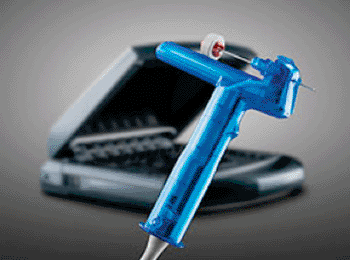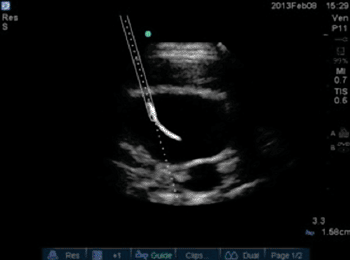Ultrasound Needle Guidance Technology Provides Real-Time Visual Updates of Needle Location
|
By MedImaging International staff writers Posted on 20 May 2013 |

Image: AxoTrack needle guidance technology (Photo courtesy of SonoSite)

Image: The guidance technology shown during vascular access (Photo courtesy of SonoSite).
New ultrasound needle-guidance technology integrates ultrasound with sophisticated magnetics to provide users with real-time visual updates of needle positioning as it moves through tissue to the intended target. The easy to use “point-and-shoot” design can save time and may significantly improve procedure outcomes, especially for vascular access.
Preexisting patient health disorders, such as low blood pressure, can increase the risk of complications during these procedures. The ability to simply line up the target line with the vessel and then track the “virtual needle” into the vessel can improve patient safety and the confidence of ultrasound users performing guided procedures.
Fujifilm SonoSite, Inc. (Bothell, WA, USA), a developer of bedside and point-of-care ultrasound, reported the launch of AxoTrack needle guidance technology on select SonoSite ultrasound systems. This newly developed product, named by Popular Science Magazine as one of 2012’s best new innovations, is now available for use with SonoSite M-Turbo ultrasound systems.
The launch comes with the news that SonoSite has received 510(k) clearance from the US Food and Drug Administration (FDA) to market specialized ultrasound transducers equipped with AxoTrack Technology engineered by Soma Access Systems, LLC (Greenville, SC, USA).
AxoTrack combines ultrasound with advanced magnetics to provide users with real-time visual updates of needle location as it travels through tissue to the intended target. The AxoTrack system, designed for rapid ease of use, is composed of a specially designed ultrasound transducer from SonoSite and a single-use sterile procedure kit from Soma Access Systems, LLC.
“AxoTrack needle guidance technology for SonoSite Systems brings a timely solution to health systems. By reducing vascular access time and enhancing patient safety, AxoTrack can ultimately reduce procedural risks and costs at a time when all of these points really matter to health systems,” said Kevin M. Goodwin, SonoSite’s president and CEO. “It is well recognized that ultrasound visualization improves the accuracy and safety of deep needle-based procedures. AxoTrack takes this to a new level by reducing the spatial coordination required when a needle tip is typically not seen. Now physicians can observe the “virtual needle’s” movement on the screen so they can be more accurate and avoid observed critical structures such as the carotid artery or the lung pleura. We are confident this point-and-shoot technology will significantly improve outcomes and also make guided procedures far more approachable for new users by addressing the coordination challenges sometimes faced with ultrasound needle guidance.”
An in vitro study using AxoTrack resulted in vascular access procedures that were successful on the first pass and first stick 99.3% of the time versus just 37.1% of the time when compared to the standard freehand method for ultrasound-guided central venous access. “For the first time, clinicians have clear sight of needle location as it moves inside the human body,” said Dexter Hagy, president and CEO of Soma Access Systems. “This means fewer passes for difficult-to-reach targets, greater success rates, and increased physician confidence, setting a new standard of care throughout the medical industry.”
After nearly 10 years of research and development, Soma Access Systems has refined AxoTrack into a simple and highly effective tool for a variety of ultrasound-guided procedures. Mr. Goodwin concluded, “The SonoSite collaboration with Soma to bring AxoTrack to market adds a new degree of safety, accuracy, and cost-effectiveness for health systems. Physicians that have seen the technology are amazed, and we have a large SonoSite customer base that has been waiting for it.”
Related Links:
Fujifilm SonoSite
Soma Access Systems
Preexisting patient health disorders, such as low blood pressure, can increase the risk of complications during these procedures. The ability to simply line up the target line with the vessel and then track the “virtual needle” into the vessel can improve patient safety and the confidence of ultrasound users performing guided procedures.
Fujifilm SonoSite, Inc. (Bothell, WA, USA), a developer of bedside and point-of-care ultrasound, reported the launch of AxoTrack needle guidance technology on select SonoSite ultrasound systems. This newly developed product, named by Popular Science Magazine as one of 2012’s best new innovations, is now available for use with SonoSite M-Turbo ultrasound systems.
The launch comes with the news that SonoSite has received 510(k) clearance from the US Food and Drug Administration (FDA) to market specialized ultrasound transducers equipped with AxoTrack Technology engineered by Soma Access Systems, LLC (Greenville, SC, USA).
AxoTrack combines ultrasound with advanced magnetics to provide users with real-time visual updates of needle location as it travels through tissue to the intended target. The AxoTrack system, designed for rapid ease of use, is composed of a specially designed ultrasound transducer from SonoSite and a single-use sterile procedure kit from Soma Access Systems, LLC.
“AxoTrack needle guidance technology for SonoSite Systems brings a timely solution to health systems. By reducing vascular access time and enhancing patient safety, AxoTrack can ultimately reduce procedural risks and costs at a time when all of these points really matter to health systems,” said Kevin M. Goodwin, SonoSite’s president and CEO. “It is well recognized that ultrasound visualization improves the accuracy and safety of deep needle-based procedures. AxoTrack takes this to a new level by reducing the spatial coordination required when a needle tip is typically not seen. Now physicians can observe the “virtual needle’s” movement on the screen so they can be more accurate and avoid observed critical structures such as the carotid artery or the lung pleura. We are confident this point-and-shoot technology will significantly improve outcomes and also make guided procedures far more approachable for new users by addressing the coordination challenges sometimes faced with ultrasound needle guidance.”
An in vitro study using AxoTrack resulted in vascular access procedures that were successful on the first pass and first stick 99.3% of the time versus just 37.1% of the time when compared to the standard freehand method for ultrasound-guided central venous access. “For the first time, clinicians have clear sight of needle location as it moves inside the human body,” said Dexter Hagy, president and CEO of Soma Access Systems. “This means fewer passes for difficult-to-reach targets, greater success rates, and increased physician confidence, setting a new standard of care throughout the medical industry.”
After nearly 10 years of research and development, Soma Access Systems has refined AxoTrack into a simple and highly effective tool for a variety of ultrasound-guided procedures. Mr. Goodwin concluded, “The SonoSite collaboration with Soma to bring AxoTrack to market adds a new degree of safety, accuracy, and cost-effectiveness for health systems. Physicians that have seen the technology are amazed, and we have a large SonoSite customer base that has been waiting for it.”
Related Links:
Fujifilm SonoSite
Soma Access Systems
Latest Ultrasound News
- AI-Powered Lung Ultrasound Outperforms Human Experts in Tuberculosis Diagnosis
- AI Identifies Heart Valve Disease from Common Imaging Test
- Novel Imaging Method Enables Early Diagnosis and Treatment Monitoring of Type 2 Diabetes
- Ultrasound-Based Microscopy Technique to Help Diagnose Small Vessel Diseases
- Smart Ultrasound-Activated Immune Cells Destroy Cancer Cells for Extended Periods
- Tiny Magnetic Robot Takes 3D Scans from Deep Within Body
- High Resolution Ultrasound Speeds Up Prostate Cancer Diagnosis
- World's First Wireless, Handheld, Whole-Body Ultrasound with Single PZT Transducer Makes Imaging More Accessible
- Artificial Intelligence Detects Undiagnosed Liver Disease from Echocardiograms
- Ultrasound Imaging Non-Invasively Tracks Tumor Response to Radiation and Immunotherapy
- AI Improves Detection of Congenital Heart Defects on Routine Prenatal Ultrasounds
- AI Diagnoses Lung Diseases from Ultrasound Videos with 96.57% Accuracy
- New Contrast Agent for Ultrasound Imaging Ensures Affordable and Safer Medical Diagnostics
- Ultrasound-Directed Microbubbles Boost Immune Response Against Tumors
- POC Ultrasound Enhances Early Pregnancy Care and Cuts Emergency Visits
- AI-Based Models Outperform Human Experts at Identifying Ovarian Cancer in Ultrasound Images
Channels
Radiography
view channel
World's Largest Class Single Crystal Diamond Radiation Detector Opens New Possibilities for Diagnostic Imaging
Diamonds possess ideal physical properties for radiation detection, such as exceptional thermal and chemical stability along with a quick response time. Made of carbon with an atomic number of six, diamonds... Read more
AI-Powered Imaging Technique Shows Promise in Evaluating Patients for PCI
Percutaneous coronary intervention (PCI), also known as coronary angioplasty, is a minimally invasive procedure where small metal tubes called stents are inserted into partially blocked coronary arteries... Read moreMRI
view channel
AI Tool Predicts Relapse of Pediatric Brain Cancer from Brain MRI Scans
Many pediatric gliomas are treatable with surgery alone, but relapses can be catastrophic. Predicting which patients are at risk for recurrence remains challenging, leading to frequent follow-ups with... Read more
AI Tool Tracks Effectiveness of Multiple Sclerosis Treatments Using Brain MRI Scans
Multiple sclerosis (MS) is a condition in which the immune system attacks the brain and spinal cord, leading to impairments in movement, sensation, and cognition. Magnetic Resonance Imaging (MRI) markers... Read more
Ultra-Powerful MRI Scans Enable Life-Changing Surgery in Treatment-Resistant Epileptic Patients
Approximately 360,000 individuals in the UK suffer from focal epilepsy, a condition in which seizures spread from one part of the brain. Around a third of these patients experience persistent seizures... Read moreNuclear Medicine
view channel
Novel Radiolabeled Antibody Improves Diagnosis and Treatment of Solid Tumors
Interleukin-13 receptor α-2 (IL13Rα2) is a cell surface receptor commonly found in solid tumors such as glioblastoma, melanoma, and breast cancer. It is minimally expressed in normal tissues, making it... Read more
Novel PET Imaging Approach Offers Never-Before-Seen View of Neuroinflammation
COX-2, an enzyme that plays a key role in brain inflammation, can be significantly upregulated by inflammatory stimuli and neuroexcitation. Researchers suggest that COX-2 density in the brain could serve... Read moreGeneral/Advanced Imaging
view channel
AI-Powered Imaging System Improves Lung Cancer Diagnosis
Given the need to detect lung cancer at earlier stages, there is an increasing need for a definitive diagnostic pathway for patients with suspicious pulmonary nodules. However, obtaining tissue samples... Read more
AI Model Significantly Enhances Low-Dose CT Capabilities
Lung cancer remains one of the most challenging diseases, making early diagnosis vital for effective treatment. Fortunately, advancements in artificial intelligence (AI) are revolutionizing lung cancer... Read moreImaging IT
view channel
New Google Cloud Medical Imaging Suite Makes Imaging Healthcare Data More Accessible
Medical imaging is a critical tool used to diagnose patients, and there are billions of medical images scanned globally each year. Imaging data accounts for about 90% of all healthcare data1 and, until... Read more
Global AI in Medical Diagnostics Market to Be Driven by Demand for Image Recognition in Radiology
The global artificial intelligence (AI) in medical diagnostics market is expanding with early disease detection being one of its key applications and image recognition becoming a compelling consumer proposition... Read moreIndustry News
view channel
GE HealthCare and NVIDIA Collaboration to Reimagine Diagnostic Imaging
GE HealthCare (Chicago, IL, USA) has entered into a collaboration with NVIDIA (Santa Clara, CA, USA), expanding the existing relationship between the two companies to focus on pioneering innovation in... Read more
Patient-Specific 3D-Printed Phantoms Transform CT Imaging
New research has highlighted how anatomically precise, patient-specific 3D-printed phantoms are proving to be scalable, cost-effective, and efficient tools in the development of new CT scan algorithms... Read more
Siemens and Sectra Collaborate on Enhancing Radiology Workflows
Siemens Healthineers (Forchheim, Germany) and Sectra (Linköping, Sweden) have entered into a collaboration aimed at enhancing radiologists' diagnostic capabilities and, in turn, improving patient care... Read more




















